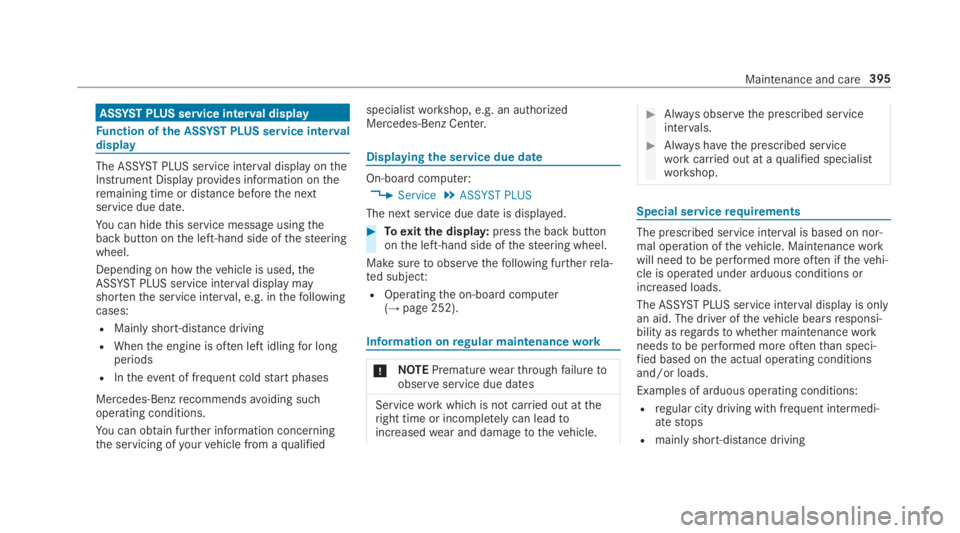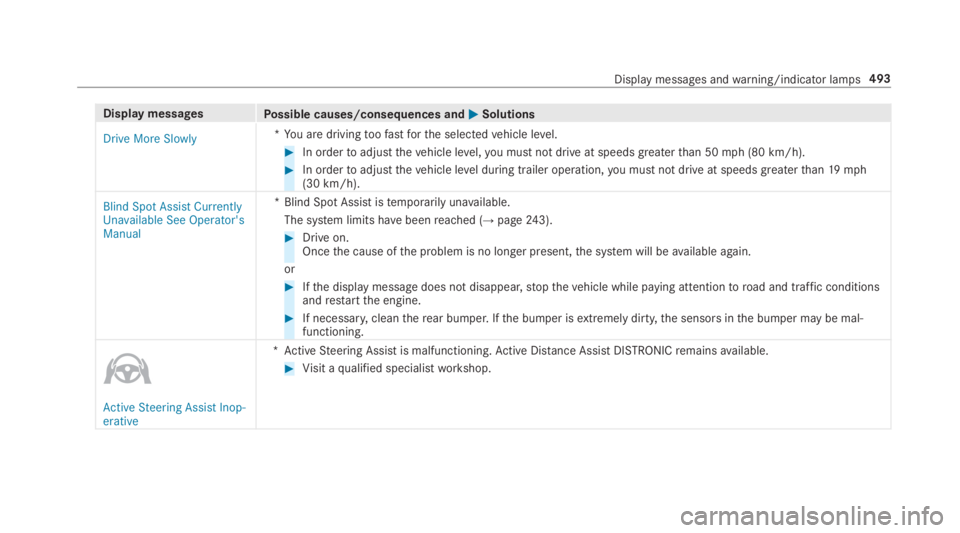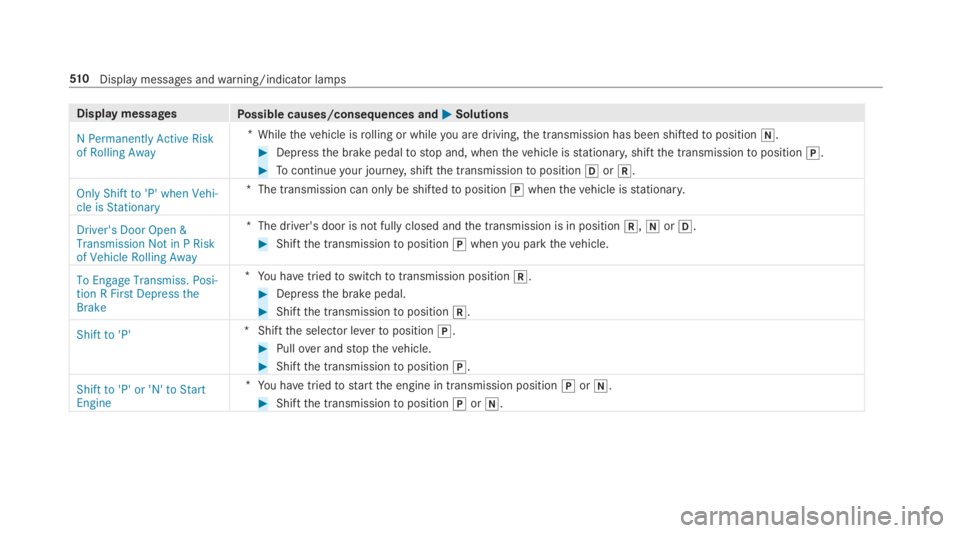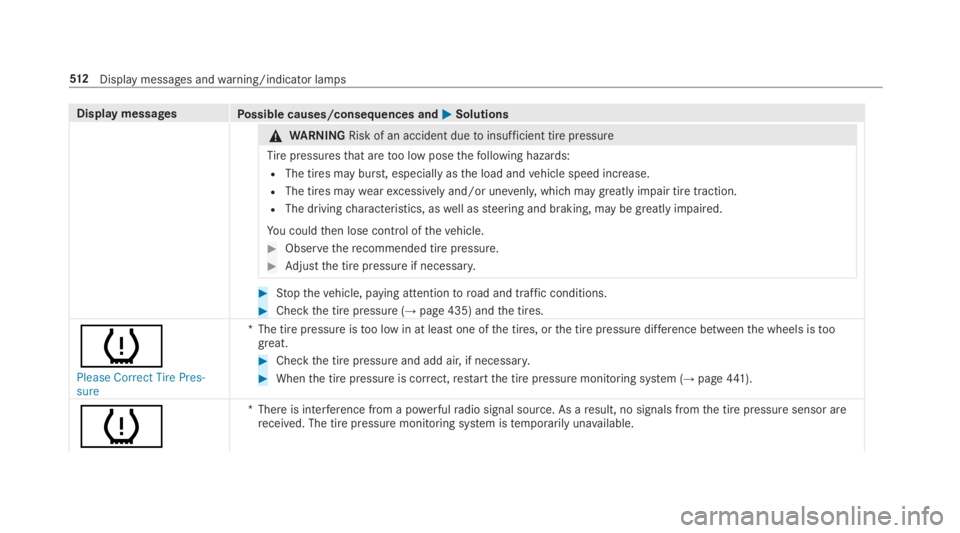2019 MERCEDES-BENZ S CLASS stop start
[x] Cancel search: stop startPage 397 of 578

ASSYST PLUS service interval display
Function ofthe ASSYST PLUS service intervaldisplay
The ASSYST PLUS service interval display ontheInstrument Display provides information ontheremaining time or distance beforethe nextservice due date.
You can hidethis service message usingtheback button onthe left-hand side ofthesteeringwheel.
Depending on howthevehicle is used,theASSYST PLUS service interval display mayshortenthe service interval, e.g. inthefollowingcases:
RMainly short-distance driving
RWhenthe engine is often leftidlingfor longperiods
RIntheevent of frequent coldstart phases
Mercedes-Benzrecommendsavoiding suchoperating conditions.
You can obtain further information concerningthe servicing ofyourvehicle from aqualified
specialistworkshop, e.g. an authorizedMercedes-Benz Center.
Displayingthe service due date
On-board computer:
,Service.ASSYST PLUS
The next service due date is displayed.
#Toexitthe display:pressthe back buttononthe left-hand side ofthesteering wheel.
Make suretoobservethefollowing furtherrela‐ted subject:
ROperatingthe on-board computer(→page 252).
Information onregular maintenancework
*NOTEPrematurewearthroughfailuretoobserveservice due dates
Serviceworkwhich is not carried out attheright time or incompletelycan leadtoincreasedwear and damagetothevehicle.
#Always observethe prescribed serviceintervals.
#Always havethe prescribed serviceworkcarried out at aqualified specialistworkshop.
Special servicerequirements
The prescribed service interval is based on nor‐mal operation ofthevehicle. Maintenanceworkwill needtobe performed more often ifthevehi‐cle is operated under arduous conditions orincreased loads.
The ASSYST PLUS service interval display is onlyan aid. The driver ofthevehicle bearsresponsi‐bility asregardstowhether maintenanceworkneedstobe performed more oftenthan speci‐fied based onthe actual operating conditionsand/or loads.
Examples of arduous operating conditions:
Rregular city driving with frequent intermedi‐atestops
Rmainly short-distance driving
Maintenance and care395
Page 428 of 578

Towingthevehicle with bothaxles ontheground
#Observethe notes onthe permittedtowingmethods (→page 424).
#Make surethatthe battery is connected andcharged.
Whenthe battery is discharged,thefollowingactions cannot be performed:
Rthe engine cannotbestarted
Rthe electric parking brake cannotbereleasedor applied
Rthe automatic transmission cannotbe shiftedtoposition�\\or�]
%Ifthe automatic transmission cannotbe shif‐tedtoposition�\\, orthe multifunction dis‐play inthe instrument cluster does not showanything, havethevehicle transportedaway(→page 427). Atowingvehicle with liftingequipment isrequiredforvehicle transporta‐tion.
*NOTEDamagedueto towingawayatexcessively high speeds orover long dis‐tances
The drivetrain could be damaged whentow‐ing atexcessively high speeds orover longdistances.
#Atowing speed of 30mph (50 km/h)must not beexceeded.
#Atowing distance of 30 miles (50 km)mustnot beexceeded.
&WARNINGRisk of accident whentowingavehicle which istoo heavy
Ifthevehicle beingtow-started ortowedawayis heavierthanthe permissible grossmass ofyourvehicle,thefollowing situationscan occur:
RThetowingeye may become detached.
RThevehicle/trailer combination mayswerveorevenoverturn.
#If anothervehicle istow-started ortowedaway, itsweight must notexceed
the permissible gross mass ofyourownvehicle.
If avehicle must betow-started ortowedaway,itsweight must notexceedthe permissible grossmass ofthetowingvehicle.
#Information onthe permissible gross mass ofthevehicle can befound onthevehicle iden‐tification plate (→page 466).
#Do not openthe driver's door or frontpassenger door,otherwisethe automatictransmission automatically shiftstoposition�].#Installthetowingeye (→page 429).
#Fastenthetow bar.
*NOTEDamageduetoincorrect connec‐tion
#Only connectthetowrope ortow bartothetowingeyes.
#Deactivatethe automatic locking mechanism(→page 68).
426Breakdown assistance
Page 441 of 578

Furtherrelated subjects:
RNotes on tire pressure (→page 435)
RTirepressuretable (→page 437)
RTireand Loading Information placard(→page442)
Tirepressure monitoring system
Function ofthe tire pressure monitoring sys‐tem
&DANGERRisk of accident duetoincor‐rect tire pressure
Every tire, includingthe spare (if provided),should bechecked when cold at least once amonth and inflatedtothe pressurerecom‐mendedbythevehicle manufacturer (seeTireand Loading Information placard ontheB-pillar onthe driver’sside orthe tire pres‐sure label onthe inside ofthe fuelfillerflapofyourvehicle). Ifyourvehicle has tires of adifferent sizethanthe size indicated ontheTireand Loading Information placard orthe
tire pressuretable,you needtodeterminethe proper tire pressureforthose tires.
As an added safetyfeature,yourvehicle hasbeen equipped with a tire pressure monitor‐ing system (TPMS)that illuminates a low tirepressure indicator lamp when one or more ofyour tires are significantly underinflated.Accordingly, ifthe low tire pressure indicatorlamp lights up,you shouldstop andcheckyour tires as soon as possible, and inflatethemtothe proper pressure. Driving on asignificantly underinflated tire causesthe tiretooverheat and can leadtotirefailure.Underinflation also increases fuel consump‐tion andreduces tire tread life, and mayaffectthevehicle's handling and braking abil‐ity. Please notethatthe TPMS is not a substi‐tutefor proper tire maintenance, and it isthedriver'sresponsibilitytomaintain correct tirepressure,even if underinflation has notreachedthe leveltotrigger illumination ofthe TPMS low tire pressure indicator lamp.
Yourvehicle has also been equipped with aTPMS malfunction indicatortoindicate when
the system is not operating properly. TheTPMS malfunction indicator is combined withthe low tire pressure indicator lamp. Whenthe system detects a malfunction,the indica‐tor lamp willflashfor approximatelya minuteandthenremain continuously illuminated.This sequence will continue upon subsequentvehiclestart-ups as long asthe malfunctionexists.
Whenthe malfunction indicator is illumina‐ted,the system may not be abletodetect orsignal low tire pressure as intended. TPMSmalfunctions may occurfor avariety ofrea‐sons, includingthe installation of incompati‐blereplacement or alternate tires or wheelsonthevehiclethat preventthe TPMS fromfunctioning properly.
Alwayscheckthe TPMS malfunctionwarninglamp afterreplacing one or more tires orwheels onyourvehicletoensurethatthereplacement or alternate tires and wheelsallowthe TPMStocontinuetofunction prop‐erly.
Wheels and tires439
Page 487 of 578

Display messagesPossible causes/consequences and�P�PSolutions
RExtended country driving withoutother traffic, e.g. inthe desert
Driving systems and driving safety systems may be malfunctioning ortemporarily unavailable.
Oncethe cause ofthe problem is no longer present, driving systems and driving safety systems will beavailableagain.
Ifthe display message does not disappear:
#Pullover andstopthevehicle safely as soon as possible, paying attentiontoroad and traffic conditions.
#Clean all sensors (→page 409).
#Restartthe engine.
�%
�
Page 493 of 578

Display messagesPossible causes/consequences and�P�PSolutions
Active Brake Assist Func-tions Limited See Opera-tor's Manual
*Vehicles with Driving AssistancePackage:Active Brake Assistwith cross-traffic function, EvasiveSteering
Assist or PRE‑SAFE®PLUS is malfunctioning.
Vehicles without Driving AssistancePackage:Active Brake Assistis malfunctioning.
#Visit aqualified specialistworkshop.
Active Brake Assist Func-tions Currently Limited SeeOperator's Manual
*Vehicles withthe Driving AssistancePackage:Active Brake Assistwith cross-traffic function, EvasiveSteering
Assist or PRE‑SAFE®PLUS aretemporarily unavailable or only partiallyavailable.
Vehicles withoutthe Driving Assistance package:Active Brake Assististemporarily unavailable.
The ambient conditions are outsidethe system limits .
#Drive on.As soon asthe ambient conditions are withinthe system limits,the system will becomeavailable again.
#Ifthe display message does not disappear,stopthevehicle while paying attentiontoroad and traffic conditionsandrestartthe engine.
PRE-SAFE Inoperative SeeOperator's Manual
*PRE‑SAFE®functions are malfunctioning.
#Visit aqualified specialistworkshop.
Mercedes me connectServices Limited See Oper-ator's Manual
*Service limited.
Atleast one ofthe main functions ofthe Mercedes me connect system is malfunctioning.
#Observethe notes onthe diagnostics connection (→page 23).
#Visit aqualified specialistworkshop.
Display messages andwarning/indicator lamps491
Page 495 of 578

Display messagesPossible causes/consequences and�P�PSolutions
Drive More Slowly*You are drivingtoofastforthe selectedvehicle level.
#In ordertoadjustthevehicle level,you must not drive at speeds greaterthan 50mph (80 km/h).
#In ordertoadjustthevehicle level during trailer operation,you must not drive at speeds greaterthan19mph(30 km/h).
Blind Spot Assist CurrentlyUnavailable See Operator'sManual
*Blind Spot Assist istemporarily unavailable.
The system limits havebeenreached (→page243).
#Drive on.Oncethe cause ofthe problem is no longer present,the system will beavailable again.
or
#Ifthe display message does not disappear,stopthevehicle while paying attentiontoroad and traffic conditionsandrestartthe engine.
#If necessary,cleantherear bumper. Ifthe bumper isextremelydirty,the sensors inthe bumper may be mal‐functioning.
Active Steering Assist Inop-erative
*ActiveSteering Assist is malfunctioning.Active Distance AssistDISTRONICremainsavailable.
#Visit aqualified specialistworkshop.
Display messages andwarning/indicator lamps493
Page 512 of 578

Display messagesPossible causes/consequences and�P�PSolutions
N Permanently Active Riskof Rolling Away
*Whilethevehicle isrolling or whileyou are driving,the transmission has been shiftedtoposition�\\.
#Depressthe brake pedaltostop and, whenthevehicle isstationary,shiftthe transmissiontoposition�].
#Tocontinueyour journey,shiftthe transmissiontoposition�[or�^.
Only Shift to 'P' when Vehi-cle is Stationary
*The transmission can only be shiftedtoposition�]whenthevehicle isstationary.
Driver's Door Open &Transmission Not in P Riskof Vehicle Rolling Away
*The driver's door is not fully closed andthe transmission is in position�^,�\\or�[.
#Shiftthe transmissiontoposition�]whenyou parkthevehicle.
To Engage Transmiss. Posi-tion R First Depress theBrake
*You havetriedtoswitchtotransmission position�^.
#Depressthe brake pedal.
#Shiftthe transmissiontoposition�^.
Shift to 'P'*Shiftthe selector levertoposition�].
#Pullover andstopthevehicle.
#Shiftthe transmissiontoposition�].
Shift to 'P' or 'N' to StartEngine
*You havetriedtostartthe engine in transmission position�]or�\\.
#Shiftthe transmissiontoposition�]or�\\.
51 0Displaymessages andwarning/indicator lamps
Page 514 of 578

Display messagesPossible causes/consequences and�P�PSolutions
&WARNINGRisk of an accident duetoinsufficient tire pressure
Tirepressuresthat aretoo low posethefollowing hazards:
RThe tires may burst, especially asthe load andvehicle speed increase.
RThe tires maywearexcessively and/or unevenly,which may greatly impair tire traction.
RThe drivingcharacteristics, aswell assteering and braking, may be greatly impaired.
You couldthen lose control ofthevehicle.
#Observetherecommended tire pressure.
#Adjustthe tire pressure if necessary.
#Stopthevehicle, paying attentiontoroad and traffic conditions.
#Checkthe tire pressure (→page 435) andthe tires.
�w
Please Correct Tire Pres-sure
*The tire pressure istoo low in at least one ofthe tires, orthe tire pressure difference betweenthe wheels istoogreat.
#Checkthe tire pressure and add air, if necessary.
#Whenthe tire pressure is correct,restartthe tire pressure monitoring system (→page441).
�w
*There is interference from a powerfulradio signal source. As aresult, no signals fromthe tire pressure sensor arereceived. The tire pressure monitoring system istemporarily unavailable.
512Displaymessages andwarning/indicator lamps